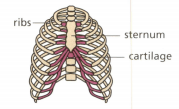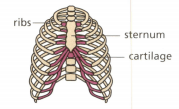Xylem cells have thick walls stiffened with lignin. Explain how this feature makes xylem adapted to transporting substances.

Important Questions on Respiration and Circulation
Carlos has a celery stalk with leaves. He cuts the bottom off the stalk. Then he puts the stalk in a glass of water mixed with blue food colouring. The next morning, the celery leaves are blue. Carlos cuts the stalk halfway up and sees small blue circles within the stalk.
Explain his observations.
Carlos has a celery stalk with leaves. He cuts the bottom off the stalk. Then he puts the stalk in a glass of water mixed with blue food colouring. The next morning, the celery leaves are blue. Carlos cuts the stalk halfway up and sees small blue circles within the stalk.
What are the blue circles inside the stalk?
Carlos has a celery stalk with leaves. He cuts the bottom off the stalk. Then he puts the stalk in a glass of water mixed with blue food colouring. The next morning, the celery leaves are blue. Carlos cuts the stalk halfway up and sees small blue circles within the stalk.
Why have the leaves turned blue?
Carlos has a celery stalk with leaves. He cuts the bottom off the stalk. Then he puts the stalk in a glass of water mixed with blue food colouring.
The next morning, the celery leaves are blue. Carlos cuts the stalk halfway up and sees small blue circles within the stalk.
Carlos's friend says that if you cut the leaves off a celery stalk, less water will be taken in by the stalk.
Plan an investigation method to find out if this might be true.
The diagram shows the ribcage.

Name an organ protected by the ribcage that pumps blood.
The diagram shows the ribcage.

Name an organ found in the ribcage that is the site of gaseous exchange.
The diagram shows the ribcage.

Cartilage joins each rib to the sternum. This allows the ribs to move.
Explain why it is important that the ribs can move.
